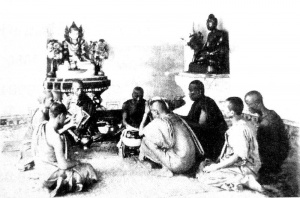Upasampada
Upasampadā (Pali) literally means "approaching or nearing the ascetic tradition." In more common parlance it specifically refers to the rite of ordination by which one undertakes the Buddhist monastic life.[1]
According to Buddhist monastic codes (Vinaya), a person must be 20 years old in order to become a monk or nun. A person under the age of 20 years cannot undertake upasampada (i.e., become a monk (bhikkhu) or nun (bhikkhuni)), but can become a novice (m. samanera, f. samaneri). (To see how a person sets out to gain upasampada, see pabbajja or "adopting the condition of mendicancy.") After a year or at the age of 20, a novice will be considered for the upasampada.[2]
Certain organizations may require a person to practice in a semi-renounced state for a set period of time for the sake of preparation and cultural familiarization.
The strictures surrounding upasampada are different for samaneras and samaneris.
Traditionally, the upasampada ritual is performed within a well demarcated and consecrated area called sima (sima malaka) and needs to be attended by a specified number of monks - "ten or even five in a remoter area" (Peter Skilling, How Buddhism invented Asia, 2009).[3]
Upasampada a practice through which a Buddhist novitiate or new Bhiksu is elevated to the status of full Bhiksu. Usually Buddhist novitiates, called shraman, begin their monastic life at 15. This stage of their life is known as pravrajya. During this period, a young Bhiksu learns the Buddhist scriptures under a mature Bhiksu. The minimum age for becoming a full Bhiksu or taking upasampada is 20. No shraman who is disabled, in debt, blind, convicted of a crime, seriously ill, or suffering from leprosy or epilepsy is allowed to take upasampada. There are eight kinds of upasampada, but only vattichatuttha kamma upasampada is administered nowadays.
The presence of at least five Bhiksus is essential at an upasampada ceremony. First the candidate';s fitness for becoming a full Bhiksu is examined. If he is found fit he has to request the Bhiksus thrice to grant him upasampada. The Bhiksus then grant him upasampada according to the prescribed practice. The decision of the Bhiksus must be unanimous.
Upasampada is one of the main Buddhist religious ceremonies. Lay persons attend this ceremony in the hope of earning blessings. This ceremony is, however, observed on a quieter note than the pravrajya ceremony. Upasampada ceremonies are held at different viharas of the country. [Sukomal Barua]
Footnotes
- ↑ Rhys Davids & Stede (1921-25), p. 147, article on "Upasampadā" (retrieved 26 Sep 2007 at http://dsal.uchicago.edu/cgi-bin/philologic/getobject.pl?c.0:1:3930.pali).
- ↑ Encyclopædia Britannica (2007).
- ↑ Peter Skilling, How Buddhism invented Asia, 2 April 2009. Peter Skilling interviewed by Phillip Adams. Online audio recording.
